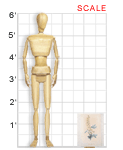From the collection of:
John James Audubon Museum || VAM Home
John James Audubon (West Indian-born, American, 1785-1851)
MAGNOLIA WARBLER, 1809
Watercolor, pastel, and graphite pencil; 17" X 10-3/4"
John James Audubon Museum
Though Audubon called this work “Black and Yellow Warbler,” the bird is known today as the magnolia warbler. The drawing was done in 1809 in Louisville, where Audubon ran a mercantile store. It would have been one of the works he showed to Alexander Wilson in 1810. Wilson, now called the “father of American ornithology,” was traveling the country selling subscriptions to his work American Ornithology when he was directed to Audubon’s store for a possible sale. While Audubon did not subscribe, he later acquired a complete set of Wilson’s work and used it as a starting place for his own masterpiece, Birds of America.
When Audubon left for England in 1826, he took all his drawings with him, intending to publish those he considered “good enough” and rework those that needed attention. This drawing must have been in that group, because Audubon either sold or gave it to someone in England. As these works were passed down through the generations, they ended up with a young girl who received them as a gift from her godfather. She was told that the burl-wood frames were valuable, but the drawings most likely were not. Decades later, in the 1990s, the burl veneer began to separate. When they were taken to a shop for repair, the owner was told that, in fact, it was the drawings that were of great value. She consigned them for auction at Sotheby’s in London, which is where they were purchased by the Friends of Audubon and the Preston Family Foundation for the Audubon Museum.
About the Artist
John James Audubon was born in Les Cayes, Santo Domingo (known today as Haiti), on April 26, 1785. Raised in France, he moved to Pennsylvania at the age of 18. In 1808, he married Lucy Blakewell.
Audubon spent 12 years in what was then frontier Kentucky, in Louisville and then Henderson, trying his hand in the business world while sketching and painting birds in his spare time. By 1820, he had given up on business and decided to study and paint birds as a career. He published his monumental book Birds of America, which featured life-size portraits of 1,065 individual birds, in four volumes between 1827 and 1838.
A self-taught artist and naturalist, Audubon was ridiculed by contemporary ornithologists, but his paintings, which depict birds in their natural state, are now renowned and widely celebrated. In 1886, a bird preservation organization adopted the artist’s name, eventually evolving into the National Audubon Society.
Suggested bibliography for grades 4-12:
- Audubon: Life and Art in the American Wilderness by Shirley Streshinsky (Villard, 1993)
- Audubon and His Journals by Maria R. Audubon (Dover, 1994)
- John James Audubon: The Making of an American by Richard Rhodes (Knopf, 2004)
- Audubon’s Birds of America by Roger Tory Peterson and Virginia Peterson (Abbeville Press, 2003)
- Darwin’s Audubon: Science and the Liberal Imagination by Gerald Weissmann (Perseus Books, 2002)
Classroom Ideas
Discussion: Based on this artwork, what kind of climate would you guess the magnolia warbler lives in? Compare this drawing to actual photographs of the magnolia warbler. How accurate is Audubon’s depiction?
Activity: Go on a field trip to a nature preserve for some birdwatching or watch birds from your home or classroom. Try to identify all the birds you see and keep a tally of how many you see. Then research the birds further at school. Are the birds you have recorded common to Kentucky? Are they in Kentucky only at certain times of the year? Where do these birds live (in trees, bushes, etc.)?
Links
Learn everything you ever wanted to know about birds, birdwatching, and the magnolia warbler at these web sites:
- Cornell University’s All About Birds
[www.birds.cornell.edu/programs/AllAboutBirds/] - Bird Identification and Biology from the Kentucky Ornithological Society
[www.biology.eku.edu/KOS/birdID.htm] - the Patuxent Wildlife Research Center
[www.mbr-pwrc.usgs.gov/id/framlst/i6570id.html]
Read a biography of Audubon at the National Audubon Society web site, where you can also flip through an online version of Birds of America.
[www.audubon.org/nas/jja.html]
[www.audubon.org/bird/BoA/BOA_index.html]
Listen to a radio interview with Richard Rhodes, author of John James Audubon: The Making of an American, from New Hampshire Public Radio.
[nhpr.org/view_content/7615/]
The National Gallery of Art includes 36 works by Audubon for viewing online.
[www.nga.gov/cgi-bin/psearch?Request=S&imageset=1&Person=750]
The Smithsonian American Art Museum includes seven works by Audubon, including Cardinal Grosbeak.
[americanart.si.edu/search/artist_bio.cfm?StartRow=1&ID=168]

